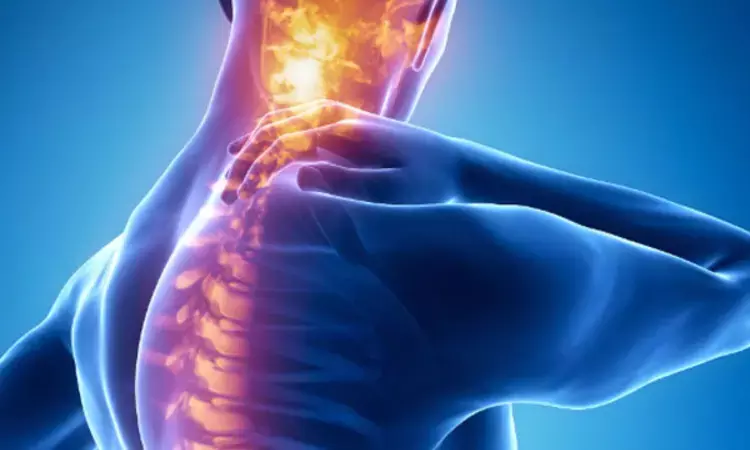- Home
- Medical news & Guidelines
- Anesthesiology
- Cardiology and CTVS
- Critical Care
- Dentistry
- Dermatology
- Diabetes and Endocrinology
- ENT
- Gastroenterology
- Medicine
- Nephrology
- Neurology
- Obstretics-Gynaecology
- Oncology
- Ophthalmology
- Orthopaedics
- Pediatrics-Neonatology
- Psychiatry
- Pulmonology
- Radiology
- Surgery
- Urology
- Laboratory Medicine
- Diet
- Nursing
- Paramedical
- Physiotherapy
- Health news
- Fact Check
- Bone Health Fact Check
- Brain Health Fact Check
- Cancer Related Fact Check
- Child Care Fact Check
- Dental and oral health fact check
- Diabetes and metabolic health fact check
- Diet and Nutrition Fact Check
- Eye and ENT Care Fact Check
- Fitness fact check
- Gut health fact check
- Heart health fact check
- Kidney health fact check
- Medical education fact check
- Men's health fact check
- Respiratory fact check
- Skin and hair care fact check
- Vaccine and Immunization fact check
- Women's health fact check
- AYUSH
- State News
- Andaman and Nicobar Islands
- Andhra Pradesh
- Arunachal Pradesh
- Assam
- Bihar
- Chandigarh
- Chattisgarh
- Dadra and Nagar Haveli
- Daman and Diu
- Delhi
- Goa
- Gujarat
- Haryana
- Himachal Pradesh
- Jammu & Kashmir
- Jharkhand
- Karnataka
- Kerala
- Ladakh
- Lakshadweep
- Madhya Pradesh
- Maharashtra
- Manipur
- Meghalaya
- Mizoram
- Nagaland
- Odisha
- Puducherry
- Punjab
- Rajasthan
- Sikkim
- Tamil Nadu
- Telangana
- Tripura
- Uttar Pradesh
- Uttrakhand
- West Bengal
- Medical Education
- Industry
Mirogabalin Useful Treatment Option for Postendodontic Neuropathic Pain, Finds Observational Study

Japan: A recent observational study has highlighted the therapeutic potential of mirogabalin in treating post-traumatic trigeminal neuropathic pain (PTTN), specifically occlusal pain that emerges following the endodontic treatment. This pain, which can significantly affect chewing and oral comfort, often proves challenging to manage with conventional dental interventions alone.
The new findings, published in the Journal of Endodontics, show how mirogabalin, a gabapentinoid, may offer a reliable and well-tolerated option for such cases.
The researchers reported that VAS scores in the provisional restoration group showed a significant decrease starting from week 6 and stabilized by week 11, which coincided with the period designated for reducing or discontinuing mirogabalin in the medication group. In patients receiving mirogabalin, a marked reduction in VAS scores was noted as early as week 1 (P < .05). Notably, even after the dose was tapered around week 7 and fully discontinued by week 11, no recurrence of pain was observed following cessation of the medication.
Building on earlier findings that highlighted the clinical efficacy of mirogabalin in managing occlusal pain resulting from post-traumatic trigeminal neuropathic pain following endodontic treatment, researchers conducted a study to explore its therapeutic use further. Conducted in line with the International Classification of Orofacial Pain criteria, Kohei Shimizu, Department of Endodontics, Nihon University School of Dentistry, Tokyo, Japan, and colleagues aimed to determine the optimal duration of mirogabalin administration and the appropriate timing for dose tapering and discontinuation, based on the treatment outcomes observed in a defined patient cohort.
For this purpose, the researchers enrolled patients with PTTN-occlusal pain linked to endodontic treatment. Retreatment was done if needed. Those who adapted to biting without medication were grouped under provisional restoration (n = 13). However, those with severe mastication pain were placed in the mirogabalin group (n = 15) and received 10 mg of the drug once daily at bedtime. Pain levels were tracked using a visual analog scale (VAS) diary maintained by patients, with additional assessments recorded during clinical visits.
The study led to the following findings:
- In the provisional restoration group, a significant reduction in VAS scores began from week 6 and stabilized by week 11.
- This observed adaptation period was used to guide the tapering and discontinuation of mirogabalin in the medication group.
- In the mirogabalin group, VAS scores showed a significant and gradual decline starting from week 1.
- The dose of mirogabalin was reduced around week 7 and completely stopped by week 11.
- No recurrence of pain was reported after tapering or discontinuing mirogabalin.
Based on these results, the study concluded that mirogabalin could be an effective and well-tolerated treatment for PTTN-related occlusal pain, particularly in patients who fail to respond adequately to dental interventions alone. Its role in managing neuropathic orofacial pain opens new avenues for improving the quality of life for affected individuals, emphasizing the importance of interdisciplinary care in dental and neurological symptom management.
Reference:
Shimizu K, Yasukawa T, Izumida T, Ozasa K, Takizawa K, Noma N, Hayashi M, Takeichi O. Mirogabalin as a Therapeutic Option for Neuropathic Pain Emerging Postendodontic Treatment: An Observational Study. J Endod. 2025 Mar;51(3):279-286. doi: 10.1016/j.joen.2024.12.015. Epub 2024 Dec 28. PMID: 39736439.
Dr Kamal Kant Kohli-MBBS, DTCD- a chest specialist with more than 30 years of practice and a flair for writing clinical articles, Dr Kamal Kant Kohli joined Medical Dialogues as a Chief Editor of Medical News. Besides writing articles, as an editor, he proofreads and verifies all the medical content published on Medical Dialogues including those coming from journals, studies,medical conferences,guidelines etc. Email: drkohli@medicaldialogues.in. Contact no. 011-43720751


